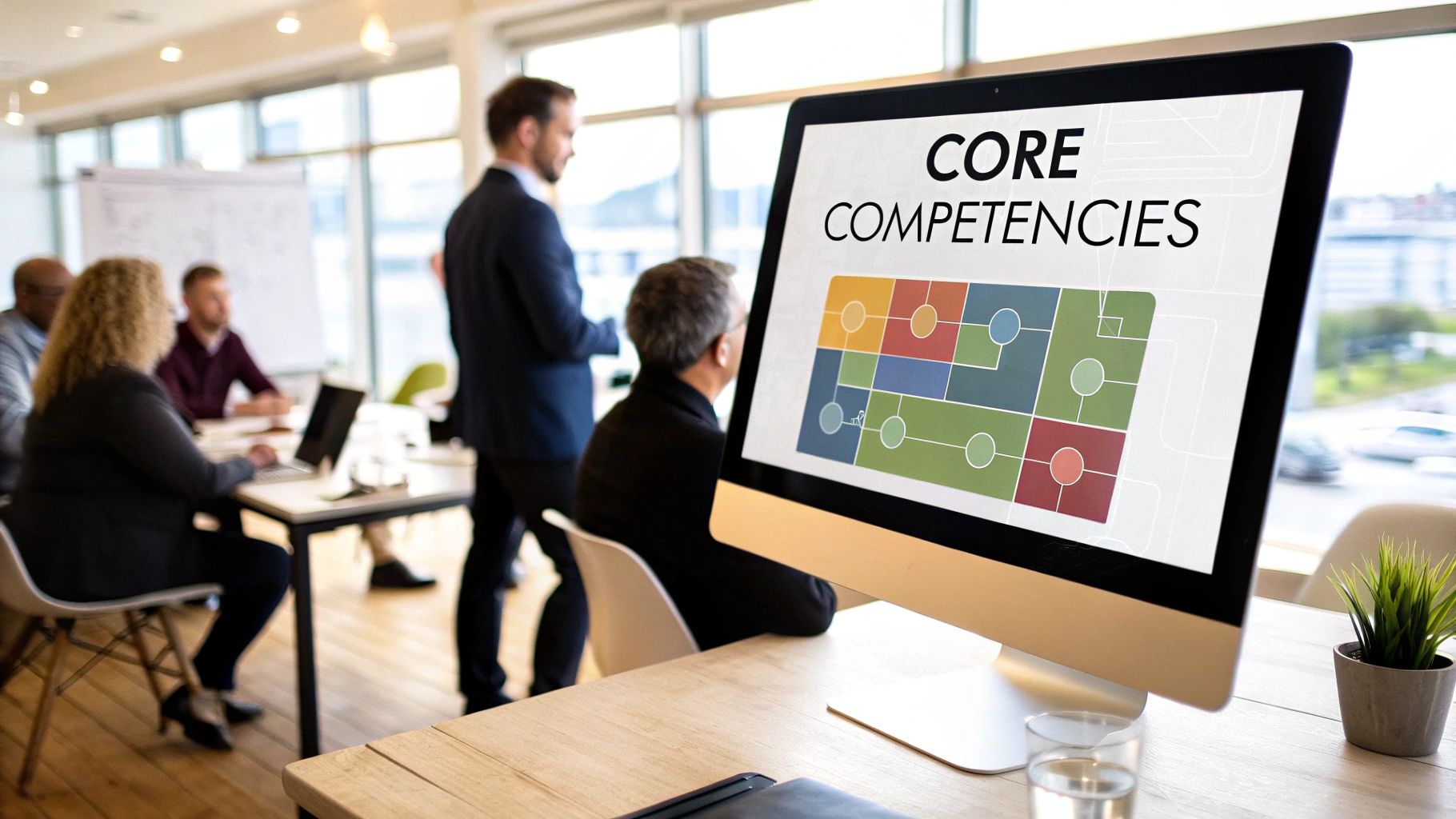Ready Your Organization for the Future
Want to ensure your organization thrives, no matter what the future holds? This listicle delivers eight succession planning best practices for 2025, equipping you to build a robust leadership pipeline and secure long-term success. Learn how to identify high-potential employees, develop key talent, and prepare for any scenario. Mastering these succession planning best practices is crucial for maintaining organizational stability and driving future growth. This list covers competency-based planning, the 9-box grid, leadership pipelines, talent pools, emergency planning, strategic job mapping, development-focused succession, and technology-enabled solutions. Get ready to build a resilient and future-ready organization.
1. Competency-Based Succession Planning
Building a robust leadership pipeline is crucial for any organization striving for long-term success. One of the most effective succession planning best practices is competency-based succession planning. This strategic approach moves beyond simply identifying high-potential individuals based on gut feeling or tenure. Instead, it focuses on identifying and developing potential successors based on a clearly defined framework of competencies – the specific skills, knowledge, and behaviors required for success in key positions. This methodology creates a more objective, transparent, and ultimately, more successful succession process. By understanding the required competencies, organizations can proactively develop employees to fill critical roles, ensuring business continuity and sustained growth.

Competency-based succession planning works by first establishing a detailed competency framework for each key role. This framework outlines the essential technical skills, leadership qualities, and behavioral attributes needed to excel in that position. Think of it as a blueprint for success. Once the framework is in place, potential successors are assessed against these competencies using various tools and methodologies, including multi-rater assessments, simulations, and performance reviews. The results of these assessments highlight individual strengths and identify any skills gaps that need to be addressed. Targeted development plans are then created to nurture and enhance these competencies, aligning individual growth with organizational needs. This continuous cycle of assessment, development, and evaluation ensures a pool of ready-now successors, equipped to step up and lead when the time comes.
Features of Competency-Based Succession Planning:
- Detailed competency framework and profiling: Clearly defined competencies for each role, forming the foundation of the entire process.
- Skills gap analysis: Pinpointing areas where individuals need further development.
- Competency assessment tools and methodologies: Utilizing diverse methods to evaluate candidates objectively.
- Targeted development plans aligned with competency requirements: Creating personalized learning paths for individual growth.
- Regular competency evaluation and tracking: Monitoring progress and ensuring continuous development.
Why this approach deserves its place in the list: This methodology takes the guesswork out of succession planning. By establishing clear, measurable criteria for success, organizations can move beyond subjective opinions and focus on developing the specific skills and behaviors needed for leadership roles. This not only strengthens the leadership pipeline but also fosters a culture of continuous learning and development.
Pros:
- Creates objective criteria for selection and development
- Focuses on specific skills rather than general potential
- Provides clear development targets
- Reduces bias in succession decisions
- Aligns development with organizational needs
Cons:
- Time-intensive to develop comprehensive competency models
- Can become overly rigid if not regularly updated
- May overemphasize technical skills vs. leadership qualities
- Risk of creating highly detailed but impractical frameworks
Examples of Successful Implementation:
- General Electric, under Jack Welch, pioneered competency-based succession planning, creating a robust leadership pipeline that fueled the company's growth for decades.
- IBM utilizes a comprehensive competency framework for leadership development, ensuring their leaders possess the skills needed to navigate the complexities of the technology industry.
- Procter & Gamble's build-from-within strategy relies heavily on competency mapping, developing future leaders from within their ranks.
Actionable Tips for Implementation:
- Focus on both technical and behavioral competencies: Leadership requires more than just technical expertise.
- Involve current role holders in defining competencies: They possess invaluable insights into the skills needed for success.
- Review and update competency models annually: Ensure the framework stays relevant in a dynamic business environment.
- Use multi-rater assessments for more accurate competency evaluation: Gain a holistic view of an individual's capabilities.
- Link competency development directly to business strategy: Ensure development efforts contribute to overall organizational goals.
When and Why to Use This Approach:
Competency-based succession planning is ideal for organizations looking to build a strong leadership pipeline based on objective criteria. It's particularly valuable in industries experiencing rapid change or facing talent shortages, as it allows for proactive development of future leaders. This method empowers organizations to identify and nurture high-potential employees, equipping them with the necessary skills to drive future success. This approach is inspired by the work of Jack Welch at General Electric, HR thought leader David Ulrich, and frameworks like Korn Ferry's Leadership Architect. By adopting this best practice, organizations can cultivate a culture of continuous growth and ensure a sustainable leadership pipeline for years to come.
2. 9-Box Grid Talent Assessment: A Cornerstone of Succession Planning Best Practices
Effective succession planning is crucial for any organization aiming for long-term success. A key component of best practices in this area is the 9-Box Grid Talent Assessment, a powerful visual tool that can revolutionize how you identify, develop, and retain top talent. This method deserves its place in the list of best practices because it provides a structured, objective framework for evaluating employees' current performance and future potential, ultimately strengthening your leadership pipeline and driving organizational growth.
The 9-Box Grid is a 3×3 matrix that plots employees based on their performance and potential. Performance is typically measured by their current contributions and achievements, while potential refers to their capacity for future growth and leadership. This creates nine distinct categories, each requiring different development and management strategies. This visual representation makes it easy to understand at a glance where your talent stands and where to focus your development efforts.
How it Works and Key Features:
The 9-Box Grid facilitates structured talent discussions and establishes a common language for succession planning across the organization. Its features include:
- Performance and Potential Matrix: The nine categories offer a comprehensive overview of talent distribution.
- Collaborative Calibration Sessions: These sessions ensure consistent evaluation across departments and mitigate bias.
- Specific Development Actions: Each box has recommended development actions, enabling personalized growth plans.
- Regular Review and Reassessment: Dynamic and ongoing, the grid adapts to changing performance and potential.
- Integration with Broader Talent Management: Seamlessly integrates with other HR processes for a holistic approach.
Why Use the 9-Box Grid in Succession Planning?
The 9-Box Grid isn't just a talent assessment; it's a strategic framework that helps you:
- Identify High-Potential Employees: Pinpoint individuals poised for leadership roles and nurture their growth.
- Mitigate Retention Risks: Identify and address potential flight risks among high-performing individuals who feel stagnant.
- Prioritize Development Investments: Allocate resources strategically to maximize impact and accelerate development.
- Create Organizational Alignment: Foster a shared understanding of talent definitions and development priorities.
Pros and Cons:
Pros:
- Visual and Easy to Understand: Facilitates quick comprehension of talent distribution.
- Meaningful Talent Conversations: Provides a structured framework for productive discussions.
- Differentiates Performance and Potential: Recognizes that current performance doesn't always predict future leadership capability.
- Prioritizes Development: Focuses resources on areas with the highest potential return.
- Creates Organizational Alignment: Establishes a shared language and understanding of talent.
Cons:
- Risk of Labeling: Can create self-fulfilling prophecies if not managed carefully.
- Subjectivity: Requires clear criteria and calibration to minimize bias.
- Overlooking Context: May not fully capture external factors impacting performance.
- Recency Bias: Evaluations can be influenced by recent events rather than long-term performance.
- Internal Competition: Can foster unhealthy competition if transparency and fairness aren't prioritized.
Actionable Tips for Implementation:
- Define Performance and Potential: Establish clear, measurable criteria relevant to your organization.
- Train Managers: Equip managers with the knowledge and skills to use the tool effectively.
- Calibration Sessions: Hold regular calibration sessions to ensure consistency across teams and departments.
- Regular Reviews: Reassess employee placement at least annually to reflect growth and changes.
- Development Plans: Create personalized development plans based on individual placement within the grid.
- Focus on Feedback: Don't share grid placement directly with employees. Instead, use it to guide development conversations.
Successful Implementations:
Industry giants like McKinsey & Company (who popularized the methodology), Microsoft, and Johnson & Johnson have successfully implemented the 9-Box Grid for talent reviews and leadership development, showcasing its effectiveness in diverse organizational contexts. These companies exemplify how the 9-Box Grid can become an integral part of succession planning best practices.
By embracing the 9-Box Grid, you're not just assessing talent; you're investing in the future of your organization. It's a proactive approach to succession planning that empowers you to identify, develop, and retain the individuals who will drive your organization forward.
3. Leadership Pipeline Model
Building a robust succession plan is crucial for any organization aiming for long-term success. One of the most effective succession planning best practices is the implementation of a Leadership Pipeline Model. This comprehensive framework, developed by Ram Charan, Stephen Drotter, and James Noel, provides a structured approach to identifying and developing future leaders at all levels of your organization. It recognizes the crucial fact that leadership requirements evolve significantly as individuals climb the organizational ladder. This model acts as a roadmap, guiding individuals through various leadership transitions and equipping them with the necessary skills for each stage.

The Leadership Pipeline Model outlines six key leadership passages, each with its own set of required skills, time applications, and work values. This framework doesn't just identify potential leaders; it empowers them with the specific tools they need to thrive at each level. This tailored approach makes the model highly effective in preparing individuals for the unique challenges they'll face as they progress in their leadership journey.
Features and Benefits:
- Six distinct leadership levels with specific requirements: This allows for a granular understanding of the skills and competencies needed at each stage.
- Clear definition of transitions between levels: Provides a clear pathway for career progression and development.
- Skills, time applications, and values required at each stage: Offers a comprehensive understanding of the evolving demands of leadership.
- Assessment tools for leadership readiness: Enables objective evaluation of individual potential and development needs.
- Development programs targeted to specific pipeline positions: Facilitates highly focused training and development initiatives.
By leveraging these features, organizations can cultivate a culture of continuous leadership development, ensuring a steady stream of qualified individuals ready to step into key roles. This model allows you to proactively identify and nurture talent, reducing the risk of leadership gaps and ensuring a smooth transition of power as leaders progress or depart.
Pros:
- Recognizes the distinct nature of leadership at different levels.
- Provides clear development paths for advancement.
- Helps identify leadership gaps across the organization.
- Reduces failure rates in leadership transitions.
- Creates a common language for leadership development.
Cons:
- May not align perfectly with flatter organizational structures.
- Can be complex to implement fully across an organization.
- Requires significant investment in development programs.
- May seem rigid in fast-changing environments.
Real-World Success Stories:
Prominent organizations like Procter & Gamble have implemented the Leadership Pipeline as a core talent management framework, demonstrating its effectiveness in fostering leadership continuity. Eli Lilly utilizes a modified pipeline model for scientific leadership development, while Bank of America’s leadership development architecture is based on pipeline principles. These examples showcase the model’s adaptability across different industries and its potential to cultivate high-performing leadership teams.
Actionable Tips for Implementing the Leadership Pipeline Model:
- Customize the model: Reflect your organization's specific leadership levels and organizational structure.
- Define clear success criteria: Establish measurable benchmarks for each leadership transition.
- Create targeted development experiences: Tailor development programs to the unique needs of each pipeline level.
- Use assessment centers: Evaluate readiness for transitions using objective assessment tools.
- Senior leadership modeling: Ensure senior leaders embody the behaviors expected at their respective pipeline levels.
When and Why to Use This Approach:
The Leadership Pipeline Model is particularly valuable for organizations committed to long-term sustainability and growth. If you are looking to establish a robust talent management system, reduce leadership transition risks, and cultivate a strong leadership bench, then incorporating this model into your succession planning best practices is highly recommended. By embracing this framework, you can empower your organization to confidently navigate the future, knowing that capable and prepared leaders are ready to step up and guide the way. While the model requires a dedicated investment, the payoff in leadership continuity and organizational success makes it a worthwhile endeavor for forward-thinking organizations.
4. Talent Acceleration Pools
One of the most impactful succession planning best practices is the development of Talent Acceleration Pools. This strategic approach moves beyond traditional, often static, replacement planning by creating dynamic pools of high-potential talent deliberately developed for multiple future leadership positions. Rather than a rigid one-to-one succession mapping exercise, this methodology builds versatile leadership capability across the organization that can be deployed flexibly as business needs evolve and unforeseen opportunities arise. This proactive strategy cultivates a bench strength ready to navigate the complexities of the modern business landscape. Individuals within these talent pools receive accelerated development opportunities, broader cross-functional experiences, and increased visibility to senior leadership, priming them for future success.

How Talent Acceleration Pools Work:
Talent Acceleration Pools operate on the principle of identifying, developing, and deploying high-potential individuals strategically. This involves a multi-faceted approach:
- Identification Criteria for Pool Membership: Establishing robust and transparent criteria is crucial for fair and effective selection. These criteria may include performance metrics, leadership potential assessments, demonstrated competencies, and alignment with organizational values.
- Cross-Functional Development Experiences: Providing opportunities for pool members to gain experience in different departments and functions broadens their perspectives and builds critical skills.
- Executive Sponsorship and Mentoring: Pairing pool members with senior leaders provides invaluable guidance, support, and insights into strategic decision-making.
- Increased Exposure to Strategic Initiatives: Involving pool members in key projects and strategic initiatives gives them valuable experience and visibility to senior leadership.
- Regular Talent Review and Pool Refreshment: Continuous evaluation of pool members' progress and periodic refreshing of the pool ensures a dynamic and relevant talent pipeline. This also allows for individuals demonstrating exceptional growth to be accelerated further, while those who may not be thriving can be transitioned to alternative development paths better suited to their strengths.
- Transparent Communication: Openly communicating the purpose, process, and criteria for pool selection and development mitigates potential misunderstandings and fosters trust.
Examples of Successful Implementation:
Several organizations have effectively implemented talent acceleration pools as part of their succession planning best practices. American Express's Leadership Pipeline program, Unilever's Future Leaders Programme, and Novartis's global talent strategy all leverage talent pools to cultivate future leaders. These programs demonstrate the power of this approach in building a robust and adaptable leadership bench.
Actionable Tips for Implementation:
- Establish Clear Criteria: Define specific, measurable, achievable, relevant, and time-bound (SMART) criteria for pool selection to ensure transparency and fairness.
- Ensure Diversity: Prioritize diversity in your talent pools to reflect the organization's values and leverage a wider range of perspectives.
- Rotate Pool Membership: Regularly review and refresh pool membership to prevent the perception of an "elite class" and provide opportunities for other high-potential employees.
- Provide Meaningful Stretch Assignments: Offer challenging and impactful projects that allow pool members to apply their skills and develop new competencies.
- Foster Networking: Create opportunities for pool members to connect, collaborate, and build relationships with each other and senior leaders.
- Executive Involvement: Engage senior executives in the development and mentoring of pool members to ensure alignment with strategic priorities.
- Transparent Communication: Clearly communicate the purpose, benefits, and expectations associated with talent pools to all employees.
Why Talent Acceleration Pools Deserve Their Place in Best Practices:
Talent Acceleration Pools are a critical component of succession planning best practices because they foster a proactive, agile, and future-oriented approach to leadership development. This method goes beyond simply identifying potential replacements; it cultivates a diverse group of versatile leaders capable of stepping up to a range of future challenges and opportunities.
Pros and Cons:
Pros:
- Creates flexibility in succession planning
- Develops versatile leaders with broader perspectives
- Reduces risk of overspecialization
- Accelerates development through focused investment
- Increases retention of high-potential talent
Cons:
- Can create perceptions of elitism or favoritism if not managed transparently
- Risk of disappointment if expectations for advancement aren't met
- Requires substantial investment for meaningful development
- Potential for creating internal competition
- May inadvertently neglect solid performers outside the pool
By embracing these best practices, organizations can build a strong leadership pipeline that drives future success. This proactive approach to talent development ensures the long-term health and competitiveness of the organization in an ever-evolving global landscape.
5. Emergency Succession Planning: Safeguarding Your Organization's Future
Emergency succession planning is a critical component of any robust succession planning best practices strategy. It's a targeted approach that focuses specifically on mitigating the risks associated with the sudden, unexpected departure of individuals in business-critical positions. Unlike comprehensive succession planning, which takes a broader, long-term view of talent development and leadership pipelines, emergency succession planning prioritizes immediate continuity. It’s about having ready-now contingency plans in place to ensure that if a key role suddenly becomes vacant, the organization can continue to function effectively. This proactive approach safeguards your organization against unforeseen circumstances, ensuring stability and resilience in the face of change.
How it Works:
Emergency succession planning works by identifying those roles crucial to the organization's daily operations and long-term strategic goals. Once these key roles are identified, designated interim successors are chosen, ready to step in immediately should the incumbent be unable to perform their duties. This process involves documenting the critical knowledge, skills, and relationships held by the incumbent, establishing clear decision-making protocols for the transition period, and developing accelerated onboarding plans for both temporary and permanent replacements. Regular testing and updating of these plans are crucial to ensure their effectiveness and relevance. Communication templates for stakeholder management are also prepared to ensure a smooth and transparent transition, minimizing disruption and maintaining confidence.
Examples of Success:
Several high-profile organizations have demonstrated the value of effective emergency succession planning. McDonald's navigated a sudden leadership transition after the unexpected death of CEO Jim Cantalupo in 2004, thanks to a well-defined emergency plan. Apple’s board maintained meticulous emergency succession plans during Steve Jobs’ health battles, ensuring stability and continuity for the company. Similarly, United Airlines implemented its emergency succession plan after CEO Oscar Munoz suffered a heart attack in 2015, demonstrating how crucial these plans are for navigating unexpected crises. These examples highlight the power of foresight and preparation in protecting an organization’s future.
Actionable Tips for Implementation:
- Review and update emergency plans at least twice yearly. The business landscape is constantly evolving, so your emergency succession plans should too.
- Create detailed knowledge capture templates for critical roles. Documenting implicit knowledge is crucial for a smooth transition.
- Practice emergency transitions through simulation exercises. This helps identify gaps and refine your plan.
- Ensure multiple people know where to find critical information. Don't let vital knowledge reside with only one person.
- Address both operational and stakeholder management aspects. Consider the impact on both internal and external stakeholders.
- Designate clear decision-making authority during transitions. This prevents confusion and ensures swift action.
- Consider temporary leadership structures that distribute responsibilities. This can alleviate the burden on a single individual.
Why Emergency Succession Planning is Essential:
Emergency succession planning deserves its place among succession planning best practices because it addresses a critical vulnerability: unforeseen circumstances. It provides a safety net, ensuring business continuity and minimizing disruption during unexpected leadership transitions. This proactive approach empowers organizations to navigate challenging situations with resilience and confidence.
Pros and Cons:
Pros:
- Reduces business disruption during unexpected transitions
- Creates organizational resilience
- Forces documentation of implicit knowledge
- Provides peace of mind for boards and leadership teams
- Can be implemented quickly even without comprehensive succession planning
Cons:
- May create focus on short-term coverage rather than long-term development
- Can feel threatening to incumbents if not positioned carefully
- Risk of plans becoming outdated if not regularly reviewed
- May create anxiety about job security if the purpose isn't clearly communicated
By understanding the pros and cons, you can implement emergency succession planning strategically and address potential concerns proactively.
This targeted approach allows organizations to react quickly and efficiently to unexpected vacancies, protecting their operations and stakeholders. By incorporating these best practices, you can ensure your organization is prepared for any eventuality, fostering a culture of preparedness and inspiring confidence in your leadership's ability to navigate the future.
6. Strategic Job Family Mapping
Strategic job family mapping is a powerful succession planning best practice that elevates your approach from reactive filling of vacancies to proactive talent cultivation. It's about strategically identifying, developing, and positioning your talent to drive future organizational success. Instead of treating all roles equally, this method recognizes that certain positions hold greater significance for your business strategy and require a more focused succession plan. This targeted approach optimizes resource allocation and ensures you're building robust talent pipelines where they matter most.
How it Works:
Strategic job family mapping involves grouping similar roles into "families" based on shared skill sets, knowledge requirements, and career progression paths. These families are then prioritized based on their impact on the organization's strategic objectives and the difficulty of filling vacancies within them. For example, highly specialized technical roles or leadership positions crucial for executing your core business strategy would likely be deemed high-priority job families.
Once prioritized, you can develop tailored succession strategies for each job family. This includes defining specific career paths, identifying high-potential employees within each family, and creating targeted development plans to prepare them for advancement. This ensures a consistent supply of qualified individuals ready to step into critical roles when needed. The process also involves analyzing movement patterns and success factors within each job family, providing valuable insights for refining your talent development initiatives.
Examples of Success:
Major organizations have effectively implemented strategic job family mapping. Microsoft, for instance, distinguishes technical leadership and product management as distinct strategic job families, tailoring their development programs accordingly. Johnson & Johnson utilizes this method across its diverse business divisions, ensuring a consistent approach to talent development despite varying business needs. Similarly, Shell has implemented strategic job family mapping for technical specialists in its petrochemical operations, recognizing the criticality of these roles for their core business.
Actionable Tips for Implementation:
- Start Strategic: Begin by pinpointing the truly strategic positions that significantly impact your business outcomes.
- Define Clear Criteria: Establish specific, measurable criteria for classifying a job family as "strategic," focusing on business impact and replacement difficulty.
- Collaborate with Leaders: Involve business leaders in prioritizing job families and defining required competencies. Their input is essential for aligning succession planning with overall business strategy.
- Analyze Historical Data: Examine past career progression patterns within each job family to identify successful development strategies and potential bottlenecks.
- Embrace Flexibility: Design your system to adapt to changing business needs. Job families and their priorities can evolve, so ensure your framework allows for reclassification.
- Consider Career Tracks: Account for both technical and leadership career paths within each job family, providing opportunities for diverse talent development.
- Measure Talent Health: Develop specific metrics to track the health of your talent pipeline within each job family, such as bench strength and time-to-fill critical roles.
Pros and Cons:
Pros:
- Concentrates resources on strategically vital positions.
- Creates more realistic and targeted career development paths.
- Unveils hidden talent bottlenecks and potential shortages.
- Provides valuable context for individual development decisions.
- Strengthens both the depth and breadth of your talent pipeline.
Cons:
- Implementation can be complex, especially in large organizations.
- Carries the risk of overlooking emerging critical roles if not regularly reviewed.
- Requires robust data analysis for optimal effectiveness.
- May encounter resistance from areas designated as less strategic.
Why This Belongs in the Best Practices List:
Strategic job family mapping is a vital component of modern succession planning best practices because it shifts the focus from simply filling vacancies to strategically building talent pipelines for critical roles. It ensures that resources are allocated efficiently and that development programs are tailored to the specific needs of the business. By adopting this approach, organizations can cultivate a robust leadership bench, adapt to changing market conditions, and achieve sustained success.
7. Development-Focused Succession Planning
Traditional succession planning often resembles filling a vacant slot—identifying someone to replace a departing leader. Development-focused succession planning, however, embraces a far more dynamic and enriching approach. This best practice in succession planning prioritizes growth, treating succession not as a mere replacement exercise, but as an ongoing journey of leadership development. It’s about cultivating a robust pipeline of talent equipped to navigate the complexities of future leadership roles, not just the demands of today.
This forward-looking methodology recognizes that high-potential individuals often require significant nurturing and tailored experiences to reach their full potential. Instead of simply slotting someone into a position, it emphasizes creating a rich portfolio of meaningful experiences, stretch assignments, and learning opportunities. This approach not only prepares individuals for advancement but also delivers substantial current business value, a crucial aspect of effective succession planning best practices.
Key Features of Development-Focused Succession Planning:
- 70-20-10 Development Model: Leveraging the renowned 70-20-10 model (70% on-the-job experience, 20% relationships, 10% formal training) ensures a balanced and holistic development approach.
- Strategic Job Rotations and Stretch Assignments: Carefully planned rotations and assignments expose individuals to diverse business functions and challenges, broadening their perspectives and skillsets.
- Action Learning Projects Tied to Business Priorities: By tackling real-world business challenges, individuals gain valuable experience and contribute directly to organizational success.
- Cross-Functional and Global Exposure Opportunities: Expanding horizons beyond immediate roles fosters adaptability and prepares future leaders for the increasing complexities of a globalized world.
- Executive Sponsorship and Mentoring Relationships: Guidance from experienced leaders provides invaluable insights, support, and networking opportunities.
- Reflection and Learning Integration Processes: Structured reflection helps individuals internalize their experiences, extract key learnings, and apply them to future challenges.
Why Development-Focused Succession Planning Deserves Its Place in Best Practices:
This approach invests in the future of your organization. By fostering a culture of continuous growth and providing employees with opportunities to expand their capabilities, you create a highly engaged and motivated workforce. This translates into increased retention, improved performance, and a stronger leadership bench prepared to steer the organization toward continued success.
Pros:
- Develops capabilities needed for future success, not just current requirements.
- Creates meaningful growth while delivering tangible business results.
- Increases engagement and retention of key talent.
- Tests potential in real situations before promotion, reducing the risk of mismatches.
- Builds organizational capability broadly, benefiting the entire organization.
Cons:
- Requires significant coordination across business units to ensure seamless transitions and effective development opportunities.
- Can disrupt operational continuity with frequent rotations, necessitating careful planning and resource management.
- Outcomes are less predictable than traditional, structured training programs.
- May face resistance from managers unwilling to release high-performing talent for developmental assignments.
- Can be difficult to scale across large organizations with complex structures.
Examples of Successful Implementation:
- Procter & Gamble: Their renowned "build from within" strategy emphasizes developmental assignments and rotations as a cornerstone of their succession planning process.
- Goldman Sachs: Their Pine Street leadership development program utilizes action learning projects to cultivate future leaders.
- Singapore's Civil Service: Employs systematic job rotations for high-potential leaders, providing broad exposure to various government functions.
Actionable Tips for Implementation:
- Create a portfolio of developmental experiences: Vary the duration and intensity of assignments to cater to individual needs and business priorities.
- Ensure support and coaching: Provide individuals with the guidance and resources they need to succeed in their stretch assignments.
- Build in reflection processes: Encourage regular reflection to maximize learning and application of new skills.
- Reward managers who develop talent: Recognize and incentivize managers who actively contribute to the growth of their team members.
- Balance operational needs with development priorities: Carefully manage rotations and assignments to minimize disruption to ongoing operations.
- Capture and apply learning: Implement mechanisms to document and disseminate the knowledge gained from rotational assignments.
- Measure the impact: Track the effectiveness of development experiences by assessing readiness and capability improvements.
Popularized By:
- Morgan McCall and the Center for Creative Leadership
- Michael Lombardo and Robert Eichinger (creators of the 70-20-10 model)
- IMD Business School's leadership development approaches
By embracing a development-focused approach to succession planning, organizations can cultivate a vibrant leadership pipeline, drive sustainable growth, and navigate the challenges of the future with confidence. This isn't merely a best practice – it's an investment in the future of your organization and the individuals who will lead it.
8. Technology-Enabled Succession Planning
In today's rapidly evolving business landscape, clinging to outdated, manual succession planning processes is like navigating with a paper map in a world of GPS. To truly optimize your organization's future, embrace the power of technology-enabled succession planning, a best practice that propels this critical function into the digital age. This modern approach leverages the strength of digital tools, analytics, and talent management systems to enhance both the effectiveness and efficiency of identifying and developing your next generation of leaders. This isn't just about automating existing processes; it's about transforming them.
Technology-enabled succession planning moves beyond simply documenting potential successors. It uses data to identify hidden talent patterns, predict future capability needs, manage development activities, and provide real-time insights to decision-makers. This allows for a more data-driven, dynamic, and comprehensive approach to succession management across the entire organization.
How it Works:
Imagine a system that seamlessly integrates talent profiles, performance reviews, learning progress, and even collaboration patterns. That's the power of technology-enabled succession planning. Integrated talent management platforms become the central hub, connecting various data points to provide a holistic view of each employee's potential. Predictive analytics identify high-potential individuals, even those who might be overlooked in traditional processes. Skills mapping and gap analysis tools pinpoint developmental needs, while real-time dashboards provide a clear picture of succession health across the organization.
Features that Empower:
- Integrated talent management platforms: A single source of truth for all talent data.
- Predictive analytics for talent identification: Unearth hidden gems and future leaders.
- Skills mapping and gap analysis tools: Pinpoint developmental needs and opportunities.
- Real-time succession metrics and dashboards: Monitor succession health at a glance.
- Digital learning and development tracking: Support growth and track progress.
- Automated career path modeling: Visualize potential career trajectories for individuals.
- Artificial intelligence for talent matching: Align individuals with the right roles.
Examples of Success:
- IBM's Watson Career Coach: Uses AI to personalize career paths and suggest relevant development opportunities.
- SAP SuccessFactors' Succession & Development module: Links performance, potential, and development activities for a comprehensive succession overview.
- Microsoft's talent analytics platform: Identifies emerging leaders by analyzing collaboration patterns and influence within the organization.
Pros of Embracing Technology:
- Scalability: Easily manage succession across large, complex organizations.
- Data-driven insights: Move beyond subjective opinions and gut feelings.
- Real-time monitoring: Stay informed of succession health and potential risks.
- Transparency and accessibility: Democratize access to talent information.
- Dynamic updates: Easily adapt succession plans to changing business needs.
- Uncovering hidden talent: Identify high-potential individuals through pattern recognition.
Cons to Consider:
- Investment: Implementing technology requires upfront investment in infrastructure and software.
- Overreliance on algorithms: Human judgment remains crucial; don't let algorithms make all the decisions.
- Data quality: Ensure data accuracy and consistency for reliable insights.
- Privacy concerns: Safeguard sensitive talent data with robust security measures.
- Complexity: Integration with existing systems can be challenging.
Actionable Tips for Implementation:
- Start with a strong foundation: Define clear succession planning processes before implementing technology.
- Prioritize data governance: Establish strong data quality and security standards.
- Integrate with existing systems: Seamless integration enhances efficiency and data flow.
- Train your leaders: Equip them to interpret and utilize succession analytics effectively.
- Balance technology with human insight: Use technology to augment, not replace, human judgment.
- Monitor implementation: Track progress and make adjustments as needed.
- Predict future needs: Leverage analytics to identify potential talent risks and gaps.
Why Technology-Enabled Succession Planning Deserves its Place:
In a world increasingly driven by data and technology, embracing a modern approach to succession planning is no longer a luxury—it's a necessity. This best practice empowers organizations to build a robust leadership pipeline, mitigate risk, and ensure long-term success. By leveraging the power of technology, you can transform succession planning from a static process into a dynamic, data-driven engine for growth. This is why technology-enabled succession planning is an essential best practice for any organization aiming to thrive in the future.
8-Point Succession Planning Strategy Comparison
| Strategy | 🔄 Complexity | ⚡ Resources | 📊 Outcomes | 💡 Ideal Use Cases | ⭐ Advantages |
|---|---|---|---|---|---|
| Competency-Based Succession Planning | High – Requires comprehensive competency frameworks | High – Involves detailed assessments and regular tracking | Objective criteria with transparent succession decisions | Organizations with clearly defined roles | Reduces bias and aligns development with strategy |
| 9-Box Grid Talent Assessment | Moderate – Involves calibration sessions and subjective measures | Moderate – Needs performance data and collaborative reviews | Visual mapping of performance and potential; clear priorities | Companies focusing on both current performance and future potential | Easy to understand, fosters alignment and prioritizes talent |
| Leadership Pipeline Model | High – Involves multiple leadership transitions and evaluations | High – Requires robust development programs and tools | Clear progression paths and gap identification | Hierarchical organizations with multi-level leadership structures | Structured progression and common leadership language |
| Talent Acceleration Pools | Moderate – Focus on pool identification and rotations | High – Involves accelerated development and mentoring | Versatile, flexible leaders prepared for various roles | Agile organizations with dynamic and diversified leadership needs | Flexibility and rapid development of high-potential talent |
| Emergency Succession Planning | Low – Focused on contingency protocols | Low-Moderate – Requires immediate coverage measures | Rapid interim coverage and minimized operational disruption | Organizations needing agile crisis-response for key positions | Quick response and increased organizational resilience |
| Strategic Job Family Mapping | High – Data-driven classification and prioritization | High – Involves extensive data analysis and tailored strategies | Optimized allocation of succession resources and focused development | Large, diverse organizations with multiple critical job families | Efficient resource allocation with strategic focus |
| Development-Focused Succession Planning | High – Emphasizes experiential learning and cross-functional rotations | High – Requires coordinated, long-term development efforts | Successor readiness through on-the-job experiences and challenges | Organizations investing in long-term leadership and experiential growth | Enhances engagement and practical leadership readiness |
| Technology-Enabled Succession Planning | Moderate to High – Involves integration of digital tools | High – Needs investment in platforms, analytics, and AI | Real-time, data-driven insights for proactive succession management | Tech-savvy, large organizations looking for dynamic tracking | Scalable, objective, and dynamically updated succession processes |
Building a Legacy of Leadership
Succession planning best practices are the cornerstone of any thriving organization. From competency-based models and 9-Box Grid talent assessments to leveraging technology and preparing for emergencies, the strategies discussed in this article provide a comprehensive roadmap for cultivating future leaders. We've explored the power of the Leadership Pipeline Model, the dynamism of Talent Acceleration Pools, and the importance of Strategic Job Family Mapping. By embracing a development-focused approach, organizations can ensure they're not just filling roles, but building a bench of talent ready to lead with vision and expertise.
Mastering these succession planning best practices isn't just about mitigating risk; it's about fostering a culture of growth, empowering individuals to reach their full potential, and ensuring the long-term health and prosperity of your organization. It's about building a legacy of leadership that will guide your organization to continued success for generations to come. By investing in your people today, you’re investing in a brighter future tomorrow.
Ready to take your succession planning efforts to the next level? The Global Human Resource Institute provides cutting-edge resources and training programs designed to equip HR professionals with the skills and knowledge needed to implement these best practices effectively. Visit the Global Human Resource Institute today to discover how we can help you build a robust leadership pipeline and secure your organization's future.




0 Comments